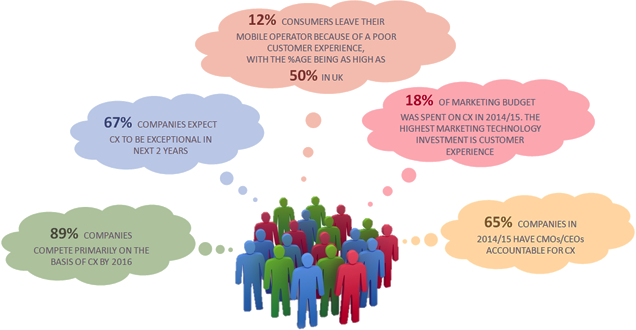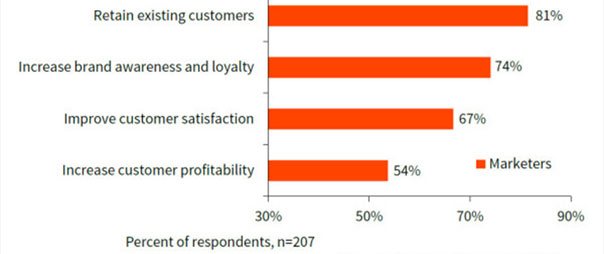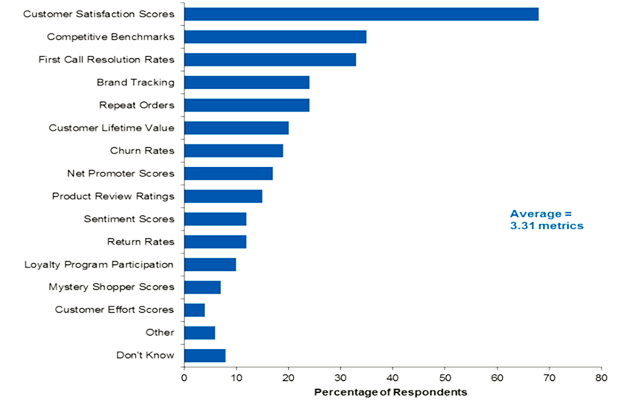Let’s face it - Today’s consumers are not deprived of options. They no longer like to be advocated to, by sellers. They are well informed, tech savvy and want to stay empowered. These increasing consumer expectations are reflected by a shift in their preferred mode of engagement with the seller, through digital channels whether it be online, over mobile, or through wearables. With this shift, organisations are being challenged to adapt, forcing Chief Marketing Officers (CMOs) to look for competitive advantages outside the traditional business model, to implement newer, more creative strategies for customer retention and loyalty. CMOs are now being tasked with driving the top-line of organisations and not just making the most efficient use of marketing budgets. With this increasing bargaining power of consumers, organisations today are making ‘digital customer experience’ (DCX) their primary competitive advantage. CMOs now have the daunting task of constantly exceeding customer expectations while at the same time having to add more shareholder value by providing quantifiable results.

Figure 1: Importance of Customer Experience – Some Facts!! (Source of data: Gartner 2014, Ovum 2015)

Figure 2: CMO Objectives: Customer Expectations vs Shareholder Value (Source: Aberdeen Group, April 2015)
How should one quantify DCX?
Organizations often find it challenging to associate quantifiable benefits while presenting business cases for their DCX initiatives. But the measurement criteria has been evolving over a period of time and the speed with which organisations are adopting digital transformation methodologies has enabled bringing to life customer experience measurement (once perceived as mythical) in the form of quantifiable numbers.
Some of the commonly used parameters to measure DCX (which ‘Customer Experience Management’ products enable organisations to capture) have been depicted below. Interestingly, while most companies focus on CSAT and NPS as the key metrics, based on a survey done by Gartner, NPS actually trails both in effectiveness and actionability.

Figure 3: Most Commonly Used DCX Metrics (Source: Gartner May 2015)
The ability to measure DCX is finding increasing relevance in most industries and Telcos are at the forefront of adopting such metrics.
Telcos & the competition from unknown quarters:
Telcos find themselves in a unique position of advantage as mobile technology forms a key, indispensable channel in the digital ecosystem. They can boast of having the most direct access to customers as people are arguably most reliant on their products especially to participate in the digital world. They literally have access to the voice of the customers and yet we see many of them struggling to maintain a share in the customer's mind.
Who would have ever imagined that a non-telco, like Google, would launch its own broadband services in the US! The global industry is constantly under pressure to rationalise players and companies like Apple are posing serious threats to Telcos, edging them into the abyss of customer ignorance. In an era where M-Pesa poses threats to the financial services industry or Samsung TV allows you to use your smartphone as a remote or Uber dramatically changes taxi hailing services, Telcos need to urgently build an ecosystem to enhance customer experience and put it at the heart of their digital evolution.
Customer Satisfaction – the holy grail?
To turn things around, Telcos are taking concrete steps to not just measure customer experience but to improve it and the chosen tool to do so seems to be 'Customer Satisfaction'.
But what exactly is customer satisfaction? Some say this is a measure of how happy your customer is or what is the likelihood of a customer recommending you to someone else (net promoter score) and that it definitely has a direct impact on an organisation's top line. Yet others argue that this is only a reflection of a customer's current state of mind and cannot be directly related to an organisation's books. But everyone agrees that only a satisfied customer can be a profitable customer. No doubt “satisfaction” is psychological but it is today globally recognised as a quantifiable measure of customer experience. Gartner defines customer experience management (which covers the journey from experience to satisfaction) 'as the practice of designing for and reacting to customer interactions to meet and exceed expectations to increase customer satisfaction, loyalty and advocacy.'
Improving customer satisfaction can mean different things to different Telcos. For example, O2 in the UK may be focussing on improving their retail store experience and making it easy for customers to buy a new product or device in their retail outlets. At the same time, EE may be interested in improving 4G penetration so that more customers can watch videos on the move in remote locations across the UK. In India, Bharti Airtel may be keen on improving ‘first call resolution’ percentage for service requests coming into their call centres and thus benefit from reduced operational costs.
The Telco industry is showing wide-spread adoption of Customer Experience Management (CEM) technologies as they need to create a consistent brand experience across various channels. For e.g. studies show that organisations use an average of 4 channels for customer interactions and in most cases they all provide different customer experiences. They need a single version of the truth, spoken and understood in the same language and making this data accessible for Customer Intelligence (CI).
The digital ecosystem has also brought to life the ability to measure a wide range of customer attributes. CMOs are increasingly working on business driven, technology initiatives to fulfil their newly set objectives. These range from implementing a “Context aware architecture” to IoT to data driven analytics. CEMs are typically in place to enable real-time business and emotional intelligence and provide strong analytics capabilities, to make sound decisions.
So, in summary, digital evolution has witnessed transformation of the intangible “customer experience” into tangible, measurable and actionable parameters such as customer satisfaction. But do CMOs need to better equip themselves to overcome the unheard, unseen challenges that this evolution brings?
About the Author
 Rishu Srivastava - Rishu works as a Business Unit Head at Torry Harris Business Solutions and handles the company’s key IT services accounts for Telecom Sector in the European region.
Rishu Srivastava - Rishu works as a Business Unit Head at Torry Harris Business Solutions and handles the company’s key IT services accounts for Telecom Sector in the European region.
Related Posts

GenAI creates new content, including images, and texts, by learning from training datasets. Its ability to simulate complex behaviors, generate novel and personalized content, adapt in real-time, and remain robust even in the face of data scarcity sets it apart from traditional AI and Machine Learning (ML) models.

Data analytics and customer research, personalization, multichannel presence, and intelligent outsourcing can make a world of a difference in the way you are perceived by your customers. When done well, this results in generating customer loyalty and translates to revenues.

Transformations aren’t easy, they don’t happen overnight and without governance and reporting measures, there is a strong possibility of failure to change and a loss of credibility for the teams involved.
Whitepaper



Analyst Speak

(THIS) has been cited among notable vendors by Forrester Research in its report ‘The API Management Software Landscape, Q1 2024’. The report recognizes Torry Harris as a provider offering API management solutions with a geographic focus in the EMEA & APAC regions.

Forrester observes that the initial rush to “lift and shift” to the cloud has now been replaced by a focus on modernization and digital transformation. Cloud migration is the first step in a long journey to take advantage of the latest cloud-native technologies and services.

Torry Harris is a 'Strong Performer' in The Q3 2022 Forrester Wave™ for API Management Solutions. This report shows how each provider measures up and helps technology architecture and delivery (TAD) professionals select the right one for their needs.
Past Webinars







